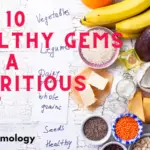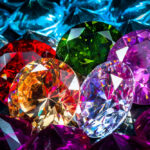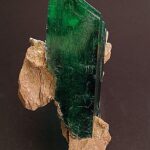What is hardest gems?
Hardest gems refer to the gemstones with an exceptionally high level of hardness that makes them suitable for industrial and decorative purposes.
Diamond is the hardest naturally occurring mineral on earth, ranking 10 on Mohs scale of mineral hardness. Additionally, other hard gemstones include ruby (9), sapphire (9), topaz (8) and emerald (7.5-8).
The durability of these gems also plays a significant role in their value and popularity among jewelry enthusiasts as well as manufacturers wanting to use them in tools and equipment such as cutting wheels or drill bits.
How to Identify and Test for the Hardest Gems
Gems, or precious stones, are in-demand for centuries. From emeralds to diamonds, sapphires to rubies – these valuable gems bring beauty and unparalleled elegance to any piece of jewelry. However, not all gemstones are equal – some require a little more effort to identify and test than others. In this blog post, we’ll explore the trickiest gems out there and how you can detect them.
First things first: what makes a gemstone so difficult? It primarily has to do with their characteristics such as color saturation (how deep the hue is), crystal formation (the pattern in which they grow), and specific gravity (a measurement of density). These factors play into how easily identifiable each type of stone is.
So let’s start!
1) Diamonds:
Although diamonds might be one of the most popular stones around, identifying between natural versus synthetic diamond can actually be quite challenging even for trained experts. Natural diamonds also come in different colors that range from white through yellowish tones or brown shades while other colored ones are extremely rare.
Testing Tip: If you see unusual patterns upon close inspection under magnification level provided by professional jeweler’s loupe then consider an identification method called SPECTRALYZER® 4000 . This device analyzes diamond spectroscopy; thus providing a clear verdict on its authenticity without prejudice towards enhanced labs grown products.
2) Tanzanite
Tanzanite was only discovered in 1967 at Tanzania’s foothills Mount Kilimanjaro area. It rapidly became very popular among consumers due to its unique tri-color display when exposed against light. Corresponding purple-blue-green hues blend together seamlessly! Unfortunately, Its popularity also opened doors for imitation versions- making tanzanites jewelers’ hardest nightmares since not only does perfect match copy costly rates but also, it’s difficult determining the authenticity of such delicately valued pieces.
Testing Tip: Tanzanites have a brittle nature and can crack easily when handled roughly; hence to avoid damaging them during testing. experts typically use non-invasive methods like ultraviolet light analysis to identify its rainbow spectrum colors while some go ahead by conducting XRF (x-ray fluorescence) tests which can analyze all tanzanite inclusion types accurately more than any other identification technique out there.
3) Alexandrite
A rare gemstone that changes color depending on lighting conditions as well as viewing angles – alexandrite is notoriously tricky since slight differences in ambient or background lights may significantly impact how this stone shifts between greens/blues and reds/purples tones at times even appears unchanged under certain lighting circumstances!
Testing Tip: An interesting fact about alexandrite gems is their unique attribute-its ability to change color-. Therefore, the standard way of checking an alexandrite’s genuineness usually involves inspecting it closely under different lightings for variations in hue transformation. However, if you’re looking for flawless accuracy regarding its origin, considering spectroscopy profilers readily available in appraisal labs will quickly sort your woes-out beyond just identity preservation since these tools gauge whether synthetic grown species mimic natural counterparts accurately at not-so-prohibitive pricing ranges nowadays.
When it comes down to precious stones, investing time into careful examination proves fundamental towards safeguarding value-preserving resources from disreputable sources passing off fakes replicas unscrupulously sold as genuine articles. Always seek professional assistance whenever uncertain because working with expert opinions creates crystal-clear results ultimately protecting one’s beloved legacy jewelry assets forevermore!
Step-by-Step Guide: Cutting and Polishing the Hardest Gems
As a professional in the gemstone industry, you may have come across some of the hardest gems like diamonds, rubies or sapphires. These precious stones are not only highly valuable but also quite challenging to cut and polish with precision. Therefore, it is crucial to know how to handle them correctly so that they retain their value and beauty.
In this step-by-step guide, we will take you through the essential processes involved in cutting and polishing the toughest of gems.
Step 1: Inspect Your Gem
Before diving into any cutting process for your gemstone, carefully examine its overall condition. Check if there are any visible cracks or flaws on the surface. Sometimes these kinds of impurities give away while in the midst of polishing. Moreover inspecting will help you figure out any possible angles and directions for carving clear patterns.
If everything looks great, it’s time to move on to planning your cuts according to what suits best for that particular piece!
Step 2: Mark Your Stone
To ensure precision during cutting, marking points are critical since they determine direction/vectors in your design structure. Use a sharp stylus pen with fine tip diameters when marking each point; make sure they’re accurate enough without causing harm by penetrating too deeply into stone coverings/structures (or worse!). Consider coating eyeliner around each spot just lightly making them more noticeable against shine reflections being caught off chisels at first place.. This technique helps during grinding/cutting procedures providing easy-to-follow guidelines.
Step 3: Diamond Cutting Wheel Preparation
Diamond wheels are commonly used throughout most industrial cutting processes. Specifically for tough materials such as carbide alloy steel, aerospace part fabrication &tools production. Nowadays,every jewelry company big or small uses one.Enduring these wheels offer a coarse surface with varying grit sizes(up to 3000grit). And it’s worth noting that The lower the number, the coarser & heavier is the cut while higher number represents very light and smooth passes.The quality of Diamond-edged cutting blades also plays an important role in these processes. After you align the diamond wheel correctly, cool it prior to use to prevent overheating by either using oil/coolant or water.
Step 4: Rough Shaping Your Gem
Now we are moving on to rough shaping this hardest material! It’s necessary to secure That particular gemstone into place according alignment procedures done beforehand.Holding positions firmly requires having stable clamps covering all edges around rimming stone slab holding machine. Begin course grinding process at your gems’ outermost point,-This would help regulate its accurate shape slowly down towards intended design level/lines respectively.As you progress make sure carefully handle dust produced During rough carving!.
Step 5: Smoothing Excess As We Progress To Finish Line
After undergoing few rounds of rough cuts, intense pressure givien onto every facet changes from being harsh. To more smooth surfaces depending on what type of finish look like. Your already shape/size piece should now have via fine cuts employing finer grain abrasive padding. Careful attention taking not too overdo sectional. Whereby extra height is likely because of chiseling. Clean your substance iron filings often coming off during smoothing moves, which linger behind less desirable scratches. Repeat these steps for each angle until completely smooth.
Step 6: Polishing Blade Application
Applying polishers(In high-end machines specifically designed for engraved sculptures) made up different materials such as ceramics,polycarbonate resins,or good old traditional felt buffs (usually containing very small amounts lead oxide), Ensuring ever single stroke assures adds value making even better looking and shining than before while eliminating any remaining bu.. Good polishing techniques can come down to having slow speed–;as this often leads more precise control over gemstone material surfaces preventing unwanted indentations/damage on already polished areas.
Step 7: Clean, Dry And Enjoy Your Hard Work
Congratulations! With the last stroke of your diamond cutting wheel you just made breathtaking masterpiece. A hard sparkler that will shine beautifully for everyones’ admiration. As you complete finishing up,, wipe clean all residue from each angle using a damp cloth or finer brush. The exact details may vary depending upon type & size guide. Take few deep breaths inhaling pleasure seeing what has taken Form from such hard work as we contemplate anew possibility looking forward future projects.
Frequently Asked Questions about Hardest Gems
Gemstones are a thing of beauty and rarity for their vibrancy, durability, and symbolism. While many gems are known for their exquisite qualities, some stones can only be described as the hardest in the world. These hardest gems exhibit unique properties such as exceptional hardness, optical clarity, and striking colors that make them highly desirable.
However, just like with any other gemstone or precious stone out there – questions frequently arise around these fascinating hard-to-find gems. To help you better understand some of the most commonly asked questions about these unique stones – we’ve compiled this definitive FAQ guide to provide insightful information about Hardest Gems.
1) What Are The Hardest Gems In The World?
The hardest mineral on Earth is diamond; it’s also one of the few substances that has consistently remained popular over time due to its stunning brilliance and toughness.
Other famously hard minerals include sapphire (corundum), ruby (also corundum), alexandrite (a color-change variety of chrysoberyl), Taaffeite, moissanite., etc.
2) How Is Gem Hardness Measured?
A mineral’s overall hardness classification depends on how well it resists scratching by another material. The Mohs scale is for determining this: it ranges from 1 to 10 where ten being Diamond- which scores highest at “10” while talc rates lowest at “1”.
3) Which Stone is Rare Yet Stunningly Beautiful?
Alexandrite ranks among the rarest gemstones globally but enjoys immense popularity due to its remarkable color-changing property under varying lighting conditions. It exemplifies nature’s diversity with hues ranging from green in daylight/reserved lightings up until beautiful purplish/red shades appearing under artificial lights.
4) What Makes Certain Stones So Valuable & Prized As Collectibles?
Several factors contribute towards making certain valuable stones valuable collectible substitutes. A few of them include rarity, scarcity from mines, brilliance/color properties, and provenance.
For example – Paraiba tourmaline is genuinely a collector’s item due to unparalleled beauty with its neon blue color and exceptional four characteristics.
5) What Are Some Essentials in Cleaning My Hardest Gems?
Gems can scratch or become damaged if you use abrasive materials for cleaning; therefore soft bristled brushes coated with gentle soap solution would be perfect for deep cleansing without causing damage.
6) How Long Do these Stones Last For?
Gemstones are resilient. But significant factors affecting longevity involve exposure to nature elements such as water/heat/cold climates. Therefore, owners should take great care & precaution when handling valuable stones and ensuring they’re safe and away from any potential harm. However on average gemstone durability varies between decades up until several centuries providing used carefully/responsibly along proper storage environment & maintenance techniques staying intact perfectly well over time!
To Conclude:
In conclusion – knowing the answers about your desired stone enables more informed decision-making when selecting precious minerals either as a gift or personal collection milestone.
Hardest gems provide fascination beyond just remarkable physical features- stories behind them including histories/provenances make collectors’ eye worth investing too😉So Hopefully this FAQ article has provided much insightful information around The World’s hardest Gemstones existing today resulting in greater appreciation alongside knowledge acquired during selection processes👍
Unbelievable Facts About the Toughest Minerals on Earth
When it comes to minerals, toughness is a crucial trait that determines their value and usage. Here are some unbelievable facts about the toughest minerals on Earth that you might not know.
1. Diamond – The Ultimate Toughie
Diamonds are known for their unparalleled hardness, making them one of the most sought-after gems on the planet. A recently discovered diamond called “The Hope” was dropped from 10 feet above a concrete floor, but didn’t break or scratch!
2. Moissanite – Diamonds’ Arch-rival
Moissanite is one of those rare minerals which almost matches diamonds when it comes to hardness and toughness. It can withstand high temperatures up to 2,000 degrees Celsius without cracking or breaking.
3. Tungsten Carbide – The Unbreakable Mineral
Tungsten carbide is often used in industries where durability and strength matter most. Think mining equipment, drill bits, saw blades etcetera because this mineral simply doesn’t give up easily! Tungsten carbide can only be cut by harder substances like diamonds themselves.
4. silicon nitride – Ceramics Superior
While ceramics may not come into everyone’s mind when thinking about tough materials; Silicon nitride has earned its reputation as one of earth’s toughest ceramic thanks to its superior resistance against abrasion and temperature changes alike; Its commonly found use includes automotive engine components (such as camshafts) among others
5.Stishovite- Not so Common
Stishovite isn’t typical. Found naturally occurring within our planet deep inside rocks. This mineral is one of the hardest minerals and provide exceptional resistance to chemical corrosion.
From Diamonds to Moissanite: The Evolution of Hardness in Gems
Gems have been beloved since ancient times. For centuries, precious stones such as diamonds were prized for their rarity and beauty. They have the ability to resist scratching or breaking. However, with advances in science and technology, we now have access to an alternative that is not only equally beautiful but also harder than diamond: moissanite.
So let’s take a closer look at how these two gems compare when it comes to hardness.
Diamonds are known for being one of the hardest natural materials on earth. They rank 10 out of 10 on the Mohs scale of mineral hardness (the standard measurement used by geologists). Meaning they can’t be scratched by anything except another diamond. This incredible durability makes them ideal for use in jewelry – especially engagement rings – where everyday wear can take a toll on lesser gemstones.
However, diamonds do have some weaknesses; while they may be hard, they’re actually quite brittle – which means they’re prone to cracking if struck at just the right angle with enough force. And even though diamonds are incredibly scratch-resistant, common household items like sandpaper or concrete can cause nicks over time – which definitely doesn’t do much good when trying to maintain that sparkling brilliance we all love!
Enter Moissanite
Sometimes called “The Jewel of the Stars” due its extraterrestrial origins discovered back in 1893 in a meteor crater (!). With gorgeous fire and brilliance that rivals even top-quality diamonds this lab-grown stone has also managed to surpass diamond in terms of sheer hardness — boasting an impressive rate of 9.25 outta’ 10 on Moh’s scale! But what does this mean? Well…let’s just say: Bye-bye chipping & scraping…if you accidentally treat your Moi wrong she won’t mind because her special structure allows her crystal matrix (in fancy language basically think micro-level construction) resist – and come out virtually unscathed!
What makes Moissanite so hard? Let’s dive into a little bit of science. This gemstone is made of silicon carbide – one of the hardest substances known to man – which gives it its impressive structure that resists being scratched or damaged. Basically, think The Terminator morphed with Shannyn Sossamon’s “40 Days and 40 Nights” character. Despite being a laboratory-grown stone (not naturally occurring like Diamonds), this does not seem to take away from its price points, as it still falls in at less than your typical diamond.
Today, many consumers are choosing moissanite over diamonds for their engagement rings because of these benefits! Not only can they find a stunningly beautiful alternative to traditional diamonds…but now also have access to a stone delivering everything good about diamond & more –improved durability and resistance—at roughly at half the cost (and without ethical complexities inherent in mining).
The Science Behind What Makes These Gemstones So Durable.
Gemstones are also popular for their durability. From diamonds to sapphires, these precious stones withstand wear and tear over time. But what exactly gives a gemstone its strength? The answer lies in the science behind their structure.
Gemstones are beneath the earth’s surface under intense pressure and high temperatures. This process requires certain minerals, resulting in diverse crystal structures that define each gemstone’s unique physical properties.
One of the essential elements in determining a gemstone’s durability is its hardness rating on the Mohs scale. Developed by German mineralogist Friedrich Mohs in 1812, this scale ranks gems from one (softest) to ten (hardest) based on how easily they can be scratched or damaged.
Diamonds are well known to top out with a perfect score of ten. Corundum— which includes both rubies and sapphires — comes next at nine. The most durable gemstones like diamonds aren’t just superiorly hard. They often possess several additional amazing features such as toughness.
Another reason why some gems seem unbreakable is thanks to their atomic lattice configuration. These crystals are composed of tightly packed layers connected by powerful chemical bonds between individual atoms called “cations”. Each cation has an electric charge whose polarity allows it to attract opposite charged ions forming an intricate network known as lattices. Basically tiny cubes tetrakaidecahedrons — within which adding impurities allow for expansive ranges of colors or transparency.
In conclusion, the durability of a gemstone can boil down to several factors, including its hardness rating and atomic lattice configuration. While some may be more prone to wear than others, all gems are everlasting marvels that afford their owners an extraordinary opportunity for lasting elegance and beauty.
Table with useful data:
| Gemstone | Hardness |
|---|---|
| Diamond | 10 |
| Moissanite | 9.25 |
| Corundum | 9 |
| Topaz | 8 |
| Sapphire | 7.5 |
Information from an Expert
As an expert in the field of gemstones, I can attest that identifying the hardest gems is no easy feat. However, diamonds undoubtedly take top honors as they rank a perfect 10 on the Mohs scale. Other hard minerals include rubies and sapphires, which both score a 9. On the other hand, some stones are notoriously difficult to cut or work with due to their inherent toughness such as jadeite and nephrite. It takes years of training and experience to be able to identify, grade and evaluate these precious materials accurately.
Historical fact: The Hope Diamond, one of the world’s most famous and valuable gems, has a long history that includes being stolen during the French Revolution and owned by several rulers including King Louis XVI and Marie Antoinette.

![Uncovering the top 10 hidden gems in hallmark movies: a guide for fans [with stats and stories] - gulfgemology](https://gulfgemology.com/wp-content/uploads/2023/05/tamlier_unsplash_Uncovering-the-Top-10-Hidden-Gems-in-Hallmark-Movies-3A-A-Guide-for-Fans--5Bwith-Stats-and-Stories-5D_1683041850-150x150.webp)





